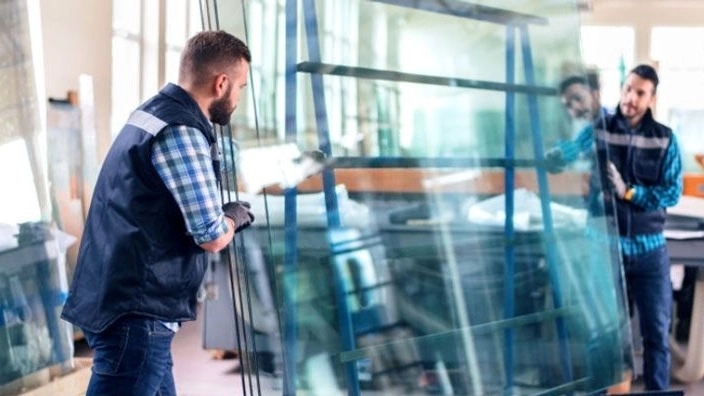✔️ شیشه ایمنی چیست؟
Safety glass is manufactured in such a way that it resists breaking due to the reinforcement, but if it is subjected to a force beyond tolerance, it will break safely. There are two types of safety glass that everyone is familiar with, laminated glass and tempered glass; But there are other types of safety glass that are used in critical situations such as theft, firearm attacks and explosions, such as bulletproof and explosion-proof glass. Safety glass or unbreakable glass works well in situations where there is a risk of damage, that's why it is used in places where safety is a priority. The high resistance of these glasses makes it possible to use them in situations where dynamic forces and environmental conditions are at work, such as trains or airplanes.
✔️ شیشه سکوریت Security glass پرکاربردترین شیشه ایمنی
✔️ شیشه لمینت Laminated glass رایج ترین شیشه ایمنی
Laminated glass is produced by gluing two or more layers of glass in a process with heat and pressure and a layer of polyvinyl butyral (PVB). The PVB layer acts like a glue when the glass is broken, allowing it to maintain its integrity despite being shattered. The fact that laminated glass can retain its shape when broken makes it an ideal choice for safety glass applications where the glass must remain in one piece, such as car windshields. One of the advantages of laminated safety glass is that it can be customized for a specific purpose, such as automotive tinted glass or UV-resistant glass. This process can be done using special coatings or additional layers inside the glass and PVB sheets.
Another advantage of laminated glass is excellent noise reduction, these glasses can block more sound than standard glass. The PVB layer prevents sound frequencies from vibrating from one panel to another, even more sound can be blocked by using thicker glass and a wider gap between the layers, which is one of the most important advantages of glass partitions in offices. to be Laminated glass is usually used in car windshields, glass facades, skylights, glass roofs, furniture, shelves and shop windows.
✔️ شیشه ضدگلوله Bullet-resistant glass، شیشه ایمنی نا آشنا
The purpose of bulletproof glass is to prevent bullets fired from a wide range of firearms at different distances. This type of safety glass usually consists of several layers of glass and a type of thermoplastic that are connected to each other and create a single sheet with a thickness of several centimeters. The glass used in bullet-resistant products is often toughened to provide greater strength and a safer collapse effect relative to heat-strengthened glass. The thermoplastic layers between this shatterproof glass can vary in type, but the two most commonly used materials are polyvinyl butyral (PVB) and polycarbonate. While PVB is the favorite of the bulletproof glass industry and has been used for many years, polycarbonate is often preferred in higher specification products due to its greater stiffness and lighter weight.
The plastic and glass layers are placed in such a way as to prevent the bullet from piercing the innermost layer; The layers of glass are harder than plastic and their job is to withstand the pressure when the bullet comes into contact and to absorb the acceleration of the bullet as it moves. Flexible plastic is there to absorb and disperse the force of the impact, spreading the bullet's energy across the plate and slowing it to a stop; At the same time, the multi-layer structure of this type of safety glass ensures that one piece remains unbroken. The usual uses of bulletproof glass are in military vehicles, money carriers, embassy cars, banks, airports and VIP transportation.

✔️ شیشه های ایمنی ضد انفجار Blast-resistant glass
In the event of an explosion, one of the biggest causes of injury and loss of life is caused by broken glass fragments that are thrown by the force of the explosion. Glass windows and doors are one of the key parts during an explosion that must be secured to protect people who may be near them. The sheer force of many blasts means that standard glass and even tempered glass simply cannot cope, creating a need for blast-resistant windows and shatterproof glass that can absorb the impact as well as a Remain in pieces. Laminated safety glass is the most effective design to meet this need, as not only do the thermoplastic layers absorb most of the blast pressure, but its layered structure means it won't shatter. In addition, the strength and flexibility of laminated glass can withstand the impact of projectiles such as rocks, shrapnel or other objects that can be scattered in an explosion. Combining this type of safety glass with an explosion-resistant frame goes a long way in making vulnerable buildings more secure. Standard blast-resistant glass is usually made with PVB layers, which have excellent impact absorption qualities, although materials such as polycarbonate can also be used to increase strength. Explosion-proof glass is used in embassies, consulates, airports, railway stations, military buildings, banks, oil and gas related facilities, and chemical and nuclear power plants. p>

